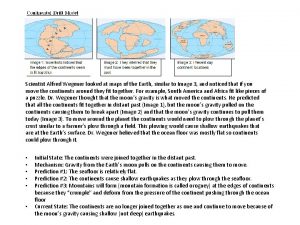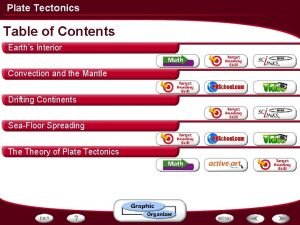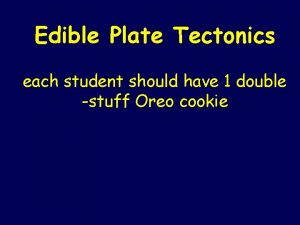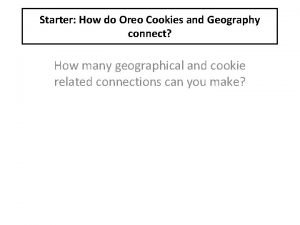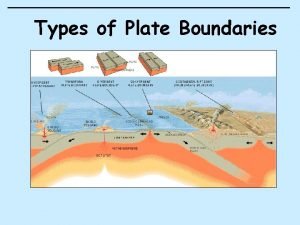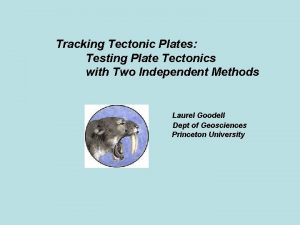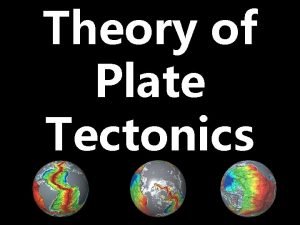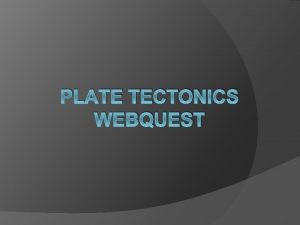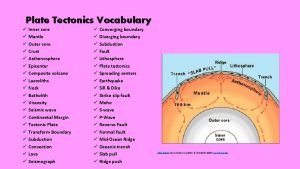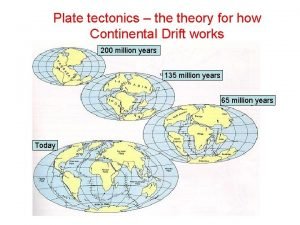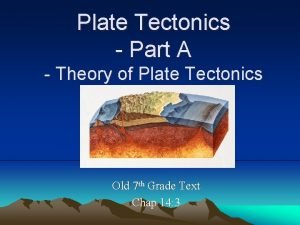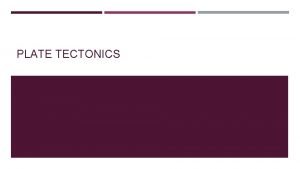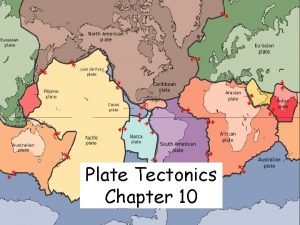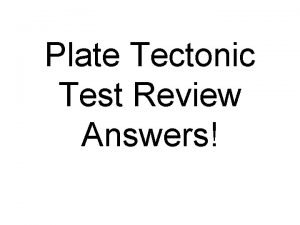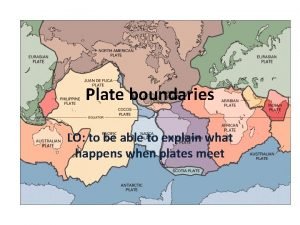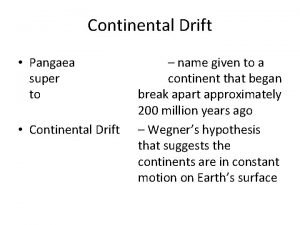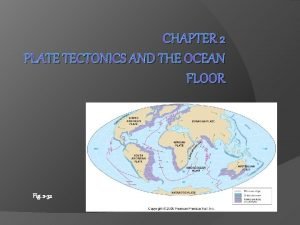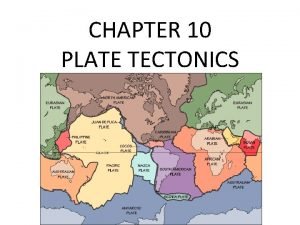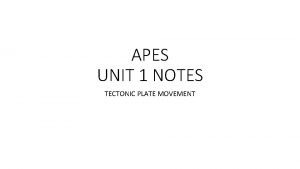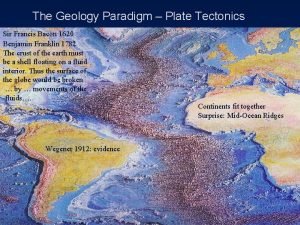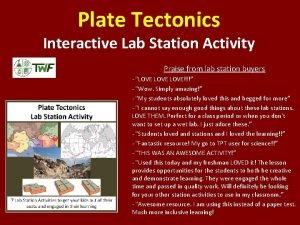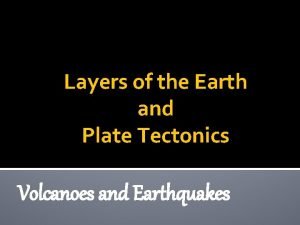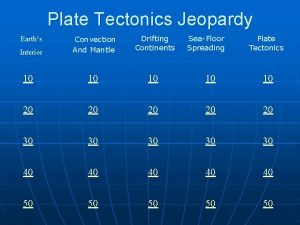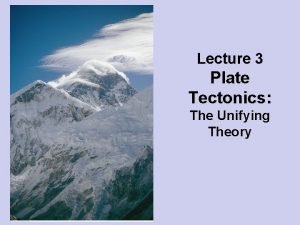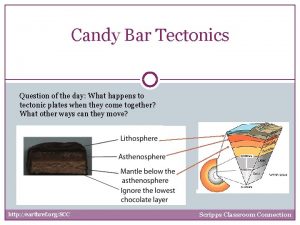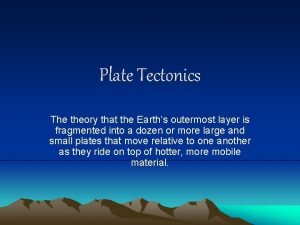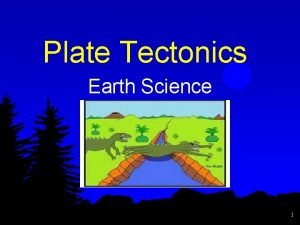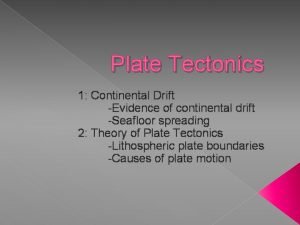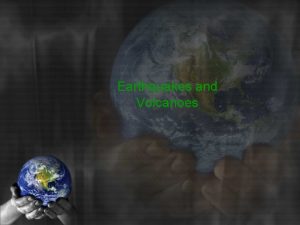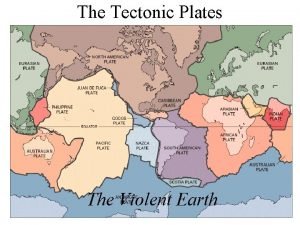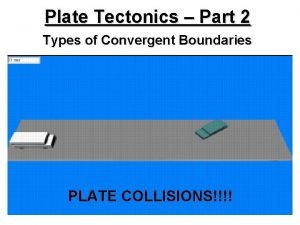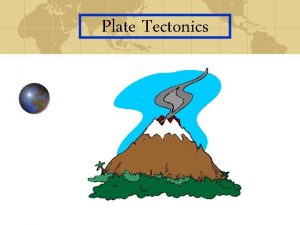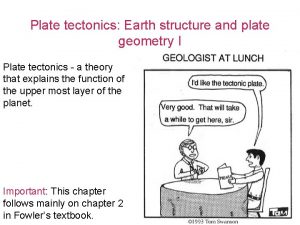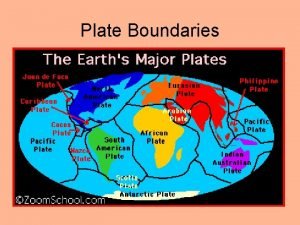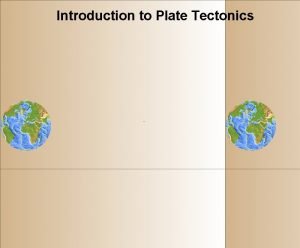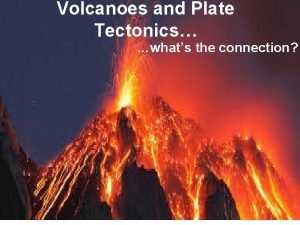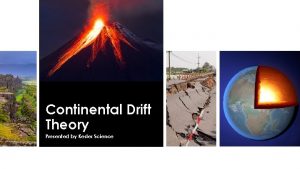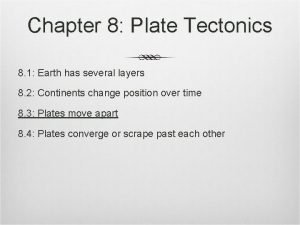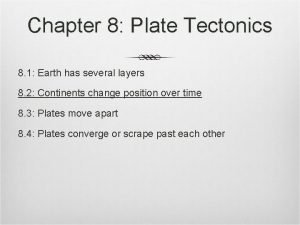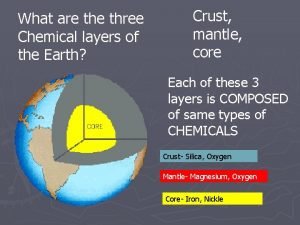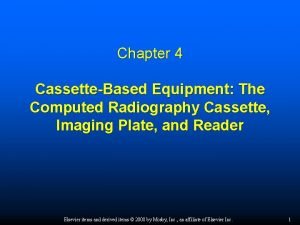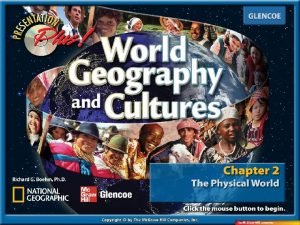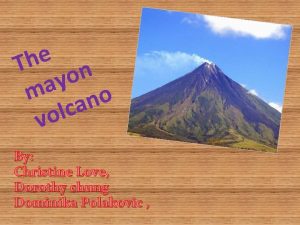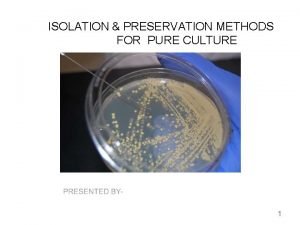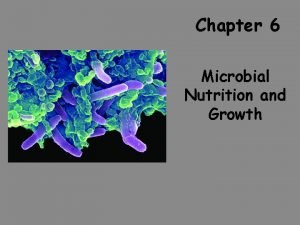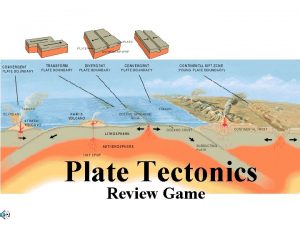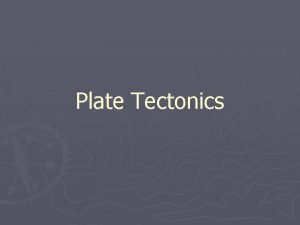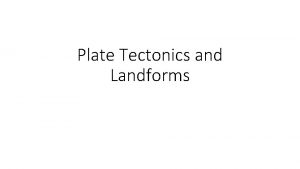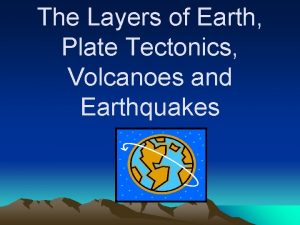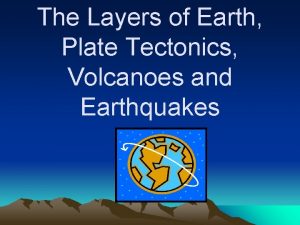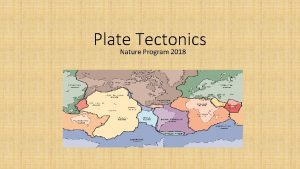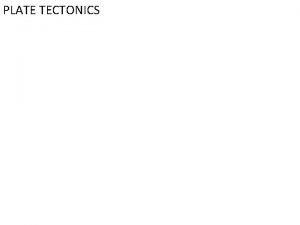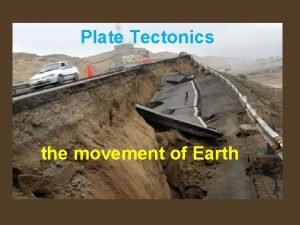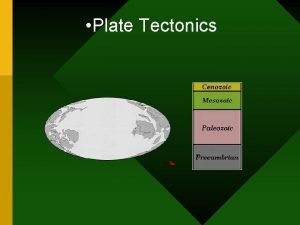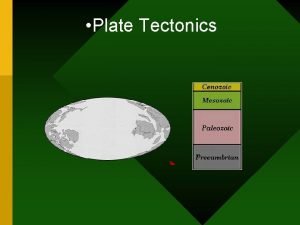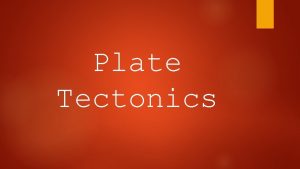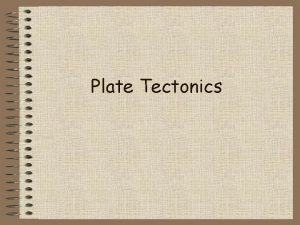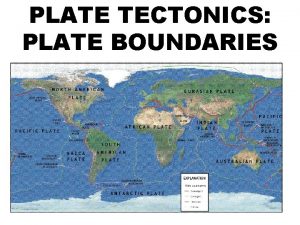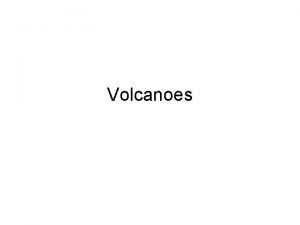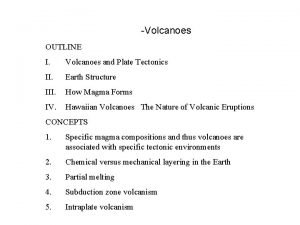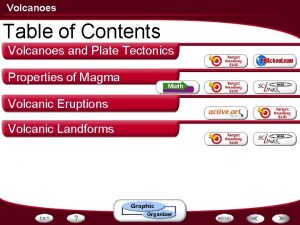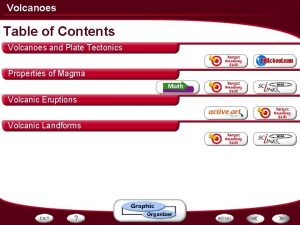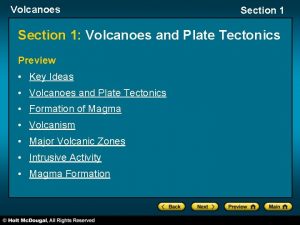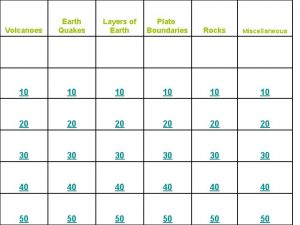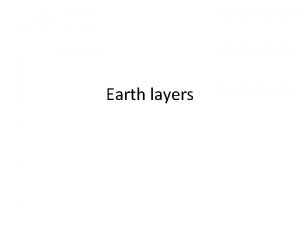Layers of the Earth and Plate Tectonics Volcanoes























































- Slides: 55

Layers of the Earth and Plate Tectonics Volcanoes and Earthquakes

Earth History: Earthquakes and Volcanoes �Key Concept: Earth’s surface is constantly changing. �Essential Question: After comparing the causes and effects of volcanoes and earthquakes, evaluate if one is worse than the other. Support your answer with evidence that is reliable, including any counter arguments.

Science Argument “Earthquake vs Volcano. . . Which is Worse? ” Argument Writing Prompt Your father has been hired by a company that has two locations. One location is the big island of Hawaii and the other location is San Francisco, CA. He can work at the location of his choice, but must make a decision soon. At first you are excited about the prospect of living in either of the two locations! But, your friends had different opinions about living in a place that has an active volcano or a place where earthquakes can occur. This lead to a debate about which is worse: a volcanic eruption or an earthquake. In your opinion, which is worse?

TURN and TALK: A’s talk to B’s �In your opinion. . . Which is worse, an earthquake or a volcanic eruption?

Activating Prior Knowledge �What do you know about the earths interior? ▪ Draw a diagram using your i. Pad to represent what you think the interior of the earth looks like? ▪ What are the layers composed of ?

Building Background Knowledge �Layers of the Earth Flip Book Fold each page of the flip book on the slash lines. Arrange the folded pages one inside the other so that the circles match at the bottom. 3) Check to see if the pages are in order by the numbers in the upper right corners. 4) Staple close to the edge on the fold in three places: middle and on each end. 5) Use the resources at your desk to write 4 facts about each layer of the earth. Color in each layer as you get to that page. 1) 2)

General Information Scientists think that the Earth was created about 5 billion years ago. At first, the Earth was just a ball of molten rock and gasses. As it began to cool, dense materials like iron sank down into its core. Lighter materials like compounds of oxygen and water rose toward the surface. That's why the Earth is made up of different layers -- as you can see in the cross section on the next slide.


The Crust �Hard and rigid, the crust is the outermost layer of the Earth �The crust is also the most narrow of the layers of the Earth. Measuring only an average of 20 miles deep under the continents. �There are two types of crust: oceanic crust and continental crust.

Song Lyrics: The Layers of The Earth (The Crust) � The continental crust’s surface is where we breathe A lot of rock up to 25 miles deep. The oceanic crust is next door It’s 3 -5 miles thick just below the ocean floor. Earth’s surface: 70% H 20. Where do you get all that water? Salty sea flow, fresh water’s in the glaciers, ice caps, and snow. � Chorus Throw your hands up for the layers of the earth Throw ‘em up for what’s below the surface Throw your hands up, and let’s discuss The inner core, outer core, mantle, and crust

The Lithosphere �Found between The Crust and The Mantle �Made up of The Crust and a little bit of The Upper Mantle �Divided into several constantly (slowly) moving plates of solid rock from which the continents and oceans are formed.

The Mantle �Is divided into two regions. The Upper Mantle, and the Lower Mantle. �This layer is dense, hot and made of hot, semisolid rock. �Found directly below the crust �About 1, 800 miles thick.

Asthenosphere �A section of the upper mantle on which the Lithosphere (tectonic) plates float Plate shown on next slide �Made of a hot semi-liquid material

TECTONIC PLATES

Song Lyrics: The Layers of The Earth (The Mantle) � Chorus Throw your hands up for the layers of the earth Throw ‘em up for what’s below the surface Throw your hands up, and let’s discuss The inner core, outer core, mantle, and crust � Verse II The mantle layer is the largest of the class. About half of our planet’s mass. The mantle is composed of very hot dense rocks, That move and flow, always on the go, they never lock, Never stop, and they’re responsible for tectonic shift Please believe the Earth’s plates are adrift It’s pretty thick and the heat is awesome 1, 600 at the top, 4, 000 at the bottom

The Core �The core is divided into two regions. �The Outer Core The only liquid layer of the Earth A sea of metal: iron and nickel 1, 800 -3, 200 miles below the Earth’s surface 1, 400 miles thick �The Inner Core Extremely hot solid ball found in the center of the Earth 3, 200 -3, 925 miles below the Earth’s surface 750 miles in diameter – about the size of the moon

Song Lyrics -The Layers of The Earth (The Core) � Chorus Throw your hands up for the layers of the earth Throw ‘em up for what’s below the surface Throw your hands up, and let’s discuss The inner core, outer core, mantle, and crust Verse I The layer we’ll discuss first Is the central inner core, in the center of the earth A solid ball buried below the dirt We believe it’s primarily metallic iron You could never take a trip to the inner core, right? The heat will burn you up, 9, 000º Fahrenheit 4, 000 miles below the Earth’s crust One down three to go y’all. 1, 800 miles from the tip top The outer core is hard at work and it don’t stop. It’s busy spinning around the inner core, and listen, This steady movement causes Earth’s magnetism. Ranging from 4 to 9, 000 degrees, It contributes 1/5 of the heat flowin’ to you and me. It’s liquid metals that violently flow So let it settle… and when you’re ready let me know. Just…

To think about. . . How do scientists know that the earth is made up of different layers? Demo: Vibrations (Seismic) waves in a Basin

The question now is…. What is causing the tectonic plates to move?

Plate Tectonics Vocabulary �Plate tectonics: theory that Earth's outer shell is divided into several plates that glide over the mantle �Tectonic plates: large plates of rock that make up the foundation of the Earth's crust and the shape of the continents. The tectonic plates comprise the bottom of the crust and the top of the Earth's mantle

How is the energy for moving the large land masses that make up Earth’s crust created?

Most of Earth's heat is stored in the mantle and there are four sources that keep it hot. First, there's the heat left over from when gravity first condensed a planet from the cloud of hot gases and particles in pre-Earth space. As the molten ball cooled, some 5 billion years ago, the outside hardened and formed a crust. The mantle is still cooling down. Read more at: http: //phys. org/news 62952904. html#j. Cp

Convection Currents Add arrows to your mantle layer to show the convection currents formed as molten rock in the mantle is heated and rises, then sinks as it becomes cooler.

How Does it Happen? Convection currents: Video Clip Plate boundaries https: //www. youtube. com/watch? v=Kg_UBLF Up. YQ

Convection Currents

The convection currents in the molten rock of the mantle work the same as convection currents in boiling water and many other situations. Convection currents in boing water: https: //search. yahoo. com/search? fr=mcafee&type=A 111 US 739&p=Simple+demonstration+ of+convection+for+Heather+and+Keira https: //www. youtube. com/watch? feature=player_embedded&v=WEDUt. S 0 IMws Convention currents are everywhere: https: //www. youtube. com/watch? feature=player_embedded&v=li. Kc. JKjv. Fc. Y

TECTONIC PLATES

Arrows show the direction of the plate movement. Length of the arrow show the rate of movement.

Plate Boundaries �Boundary The border between two tectonic plates. There are three different types of boundaries �Some boundaries are Collision Zones The place where a collision between two continental plates crunches and folds the rocks at the boundary, lifting them up and leading to mountain formation.

Floating Plates on the Earth 2002©www. Beacon. Learning. Center. com Notes t. Plate called These Plates ust tle, are Three Name Effects mid-ocean rm slowly 2 a. with nse volcanoes 2 b. forms other. 2 c. When e, ranges. common 3. ither ons same boundaries. Example Divergent the causing in Convergent rmed 2. formed collided Transform 1. fault many and one they move Divergent Convergent Transform seafloor When North Great Andes Himalayan The eastern new and subduction mountain called Earth's ocean Eurasian these continental or layer lithosphere aboundary in upper tectonics direction at earthquakes. Volcanic ways on when plates are of plate two less in San crumple pushes of opposite Earthquakes awhen the seafloor, with Rift apart together past American two the at two of part Mountains Plate below plate the composed Africa each tend continental mantle ridges dense spreading Fault Andreas these convergent mantle Mid bends the ocean two three move and boundary Valley each plates rangesfault the parts lithosphere. of Mountains away boundary states Tectonics zoneat and to sinks type plates effects arcs up floats Atlantic the directi ocean Boundary the Eurasian continental which boundaries. Indo-Australian different and occur. other and rises types boundary floor around are together plate has slide Fault upper of lithosphere from forms are of African that under -This cools can or plates slides broken when of boundary plates form been South boundary the to new plate of moving moves past ridge in the each is the move. man Plate the is speeds. at boundaries. cr the Asia to athe mountain magma under where collid plate, plates Earth's this collid ridge. each collides America surface transform mantle. into fo type less is around site away were on of type Plate the Earthquakes sections, other, the de of the of crus from at asthenosphere. boundary. of from fo on earth's boundary. e the asthenosphere. surface occur at 6/4/2002 transform fault the Nazca and the South American plates. Different Plate Boundaries �As you view each of the following slides, complete the concept map similar to the one below: Earth’s Plates Movement of Plates Boundary Name and illustration Effects Examples

Divergent Plate Boundary �The boundary that occurs where two plates are moving apart from each other. �Effects: Ridges and Seafloor Spreading

Convergent Plate Boundary �The boundary that occurs where two plates are pushing toward each other. �Effects: volcanoes, earthquakes and mountains The Himalayas Subduction Zone Examples of subduction zone volcanoes: Mt. St Helens, Krakatau (Indonesia), Ambrym (Vanuatu), Usu (Japan)

Transform plate boundary �The boundary that occurs where two plates slide past each other. �Effect: earthquakes San Andres Fault in CA

Animations of the plate boundaries http: //www. classzone. com/books/earth_science/terc/content/visualizations/es 0804 page 01. cfm? chapter_no=visualization

Plate Tectonics Lab DO NOT EAT THE COOKIE! � Sliding Plate Over Asthenosphere ▪ Use your cookie to demonstrate what this looks like. What does the white cream filling represent in the model?

Plate Tectonics Lab DO NOT EAT THE COOKIE! Divergent Plate Boundary ▪ Use your cookie to demonstrate what this looks like.

Plate Tectonics Lab DO NOT EAT THE COOKIE! Convergent Plate Boundary ▪ Use your cookie to demonstrate what this looks like.

Plate Tectonics Lab DO NOT EAT THE COOKIE! Transform Plate Boundary ▪ Use your cookie to demonstrate what this looks like.

Plate Tectonics Lab � EAT THE COOKIE! Numnumnumnum… And draw what the different boundaries look like in your notebook.


Vocabulary Continued �Fault A crack or fracture in Earth's crust where two tectonic plates grind past each other in a horizontal direction. �Rift A dropped zone where two tectonic plates are pulling apart.

Layers of the Earth Rap �Here we go again… Make sure to listen to the details in the song’s lyrics

Earthquakes and Volcanoes �What do the layers in the earth’s interior and tectonic plate boundaries have to do with earthquakes and volcanoes? Turn and Talk: 1’s talk to 2’s and 3’s talk to 4’s

REVIEW of the Types of Plate Boundaries

Review of the tectonic plate boundaries


World Volcano Distribution Pacific Ring of Fire



A closer look at Volcanoes Go to the following link on your i. Pad � http: //video. nationalgeographic. com/video/101 -videos/volcanoes-101 Volcanoes 101 – Viewing Guide Volcanoes are openings or _________ into the hot interior of the planet. About _____ volcanoes around the world or classified as active. Nearly 90% of these active volcanoes are located in a band around the Pacific Ocean called the _______. The location is no accident. Explain why. _____________________________________________________________________________ Not all lava is the same, so it creates different types of volcanoes: Shield volcanoes - _____________________________________ Composite volcanoes - _____________________________________

On your Own: Volcanoes Kids Discover Magazine: VOLCANOES �As you read the article in the magazine - take notes – What’s worse? ? ? Include in your notes: ▪ any benefits (pros) that come from ▪ Any negative aspects (cons) of volcanoes Look for any counter arguments that you need to address?

A closer look at Earthquakes Go to the following link on your i. Pad http: //video. nationalgeographic. com/video/101 -videos/earthquake-101 Earthquakes 101 - Viewing Guide 1. In ____, California had a massive earthquake along the _________ _____, shaking for _____ seconds. 2. Explain why the disaster is only beginning after the trembling stops? ____________________________________________ 3. An _________ is the trembling of the ground when masses of rock suddenly shift below the earth’s surface. 4. Though hundreds of earthquakes take place every day, most pass _________. 5. Earthquakes usually take place along lines called ________ where the plates grind against each other. 6. _________ builds up when the movement is blocked and then finally the fault gives way. 7. Released energy gives way in the form of seismic WAVES that travel through the earth. 8. These waves can be _________ on a machine called a seismograph. 9. The size of an earthquake can be graded using the Richter ______. 10. Every year about ________ earthquakes occur that are hard enough to be felt, but only about 1000 are strong enough to damage property. 11. The greatest earthquake to hit North America measured a _____ on the Richter scale in ________ in 1964. 12. What is a question you have that was not answered in the video? ____________________________________________

On your own Kids Discover Magazine: EARTHQUAKES �As you read the article in the magazine - take notes – What’s worse? ? ? Include in your notes: ▪ any benefits (pros) that come from ▪ Any negative aspects (cons) of volcanoes Look for any counter arguments that you need to address?

Take a stance…Make a claim… �At the beginning of the unit, you discussed what your first thought was about which is worse… A volcanic eruption or an earthquake? Now… Which do you think is worse? ? ?

Writing your Argument. . .
 Continental drift theory and plate tectonics theory
Continental drift theory and plate tectonics theory Compare continental drift and plate tectonics
Compare continental drift and plate tectonics Seafloor spreading material at trenches
Seafloor spreading material at trenches Plate tectonic theory vs continental drift
Plate tectonic theory vs continental drift Convergent boundary oreo
Convergent boundary oreo Oreo cookies and plate tectonics answers
Oreo cookies and plate tectonics answers Plate tectonics vs continental drift
Plate tectonics vs continental drift Marianas trench plate boundary
Marianas trench plate boundary Evidence of the theory of plate tectonics
Evidence of the theory of plate tectonics The plate tectonics theory states that
The plate tectonics theory states that Plate tectonics webquest answer
Plate tectonics webquest answer Plate tectonics vocabulary worksheet
Plate tectonics vocabulary worksheet Continental drift
Continental drift Plate tectonics definition
Plate tectonics definition Driving force of plate tectonics
Driving force of plate tectonics Concept map plate tectonics
Concept map plate tectonics Summarize the theory of plate tectonics
Summarize the theory of plate tectonics Arthur holmes contribution to plate tectonics
Arthur holmes contribution to plate tectonics Mantle magma
Mantle magma What are plates that collide head-on called?
What are plates that collide head-on called? Pangaea
Pangaea The ocean floor revealing plate tectonics
The ocean floor revealing plate tectonics Fossils as evidence of continental drift
Fossils as evidence of continental drift Plate tectonics apes
Plate tectonics apes Francis bacon plate tectonics
Francis bacon plate tectonics Plate tectonics interactive lab
Plate tectonics interactive lab Oreo plate boundaries
Oreo plate boundaries The tectonic plates float on which semiliquid layer
The tectonic plates float on which semiliquid layer Types of volcanoes
Types of volcanoes Plate tectonics game board
Plate tectonics game board Types of plate boundaries
Types of plate boundaries Candy bar tectonics
Candy bar tectonics Plate tectonics
Plate tectonics Plate tectonics
Plate tectonics Plate tectonics
Plate tectonics Plate tectonics
Plate tectonics Map of plate tectonics
Map of plate tectonics Boundaries of plate tectonics
Boundaries of plate tectonics Plate tectonics
Plate tectonics Earth rotation
Earth rotation Future plate tectonics
Future plate tectonics Theory of plate tectonics
Theory of plate tectonics Plate tectonics
Plate tectonics Layers of the earth jeopardy
Layers of the earth jeopardy Kesler science plate boundaries
Kesler science plate boundaries Chapter 8 plate tectonics
Chapter 8 plate tectonics Chapter 8 plate tectonics
Chapter 8 plate tectonics Pour plate method steps
Pour plate method steps What are earth's physical layers
What are earth's physical layers The cr cassette is backed by aluminum that
The cr cassette is backed by aluminum that Earth's surface
Earth's surface Chapter 8 earthquakes and volcanoes
Chapter 8 earthquakes and volcanoes Interesting facts about mt mayon
Interesting facts about mt mayon Destructive process examples
Destructive process examples Culture pure
Culture pure Pour plate vs streak plate
Pour plate vs streak plate

